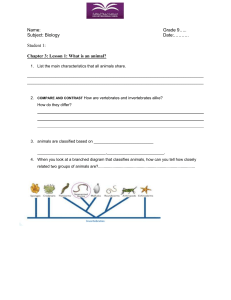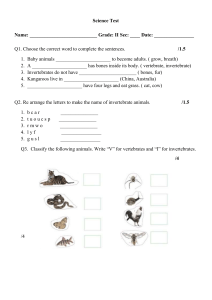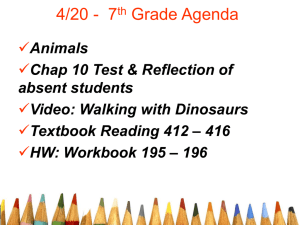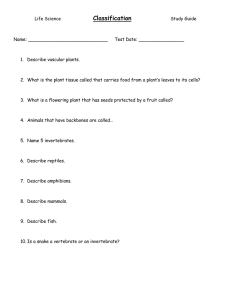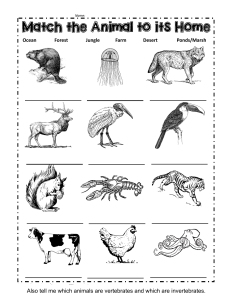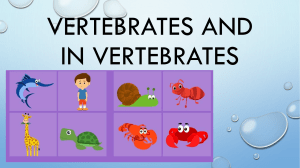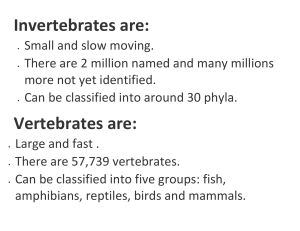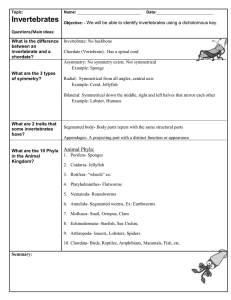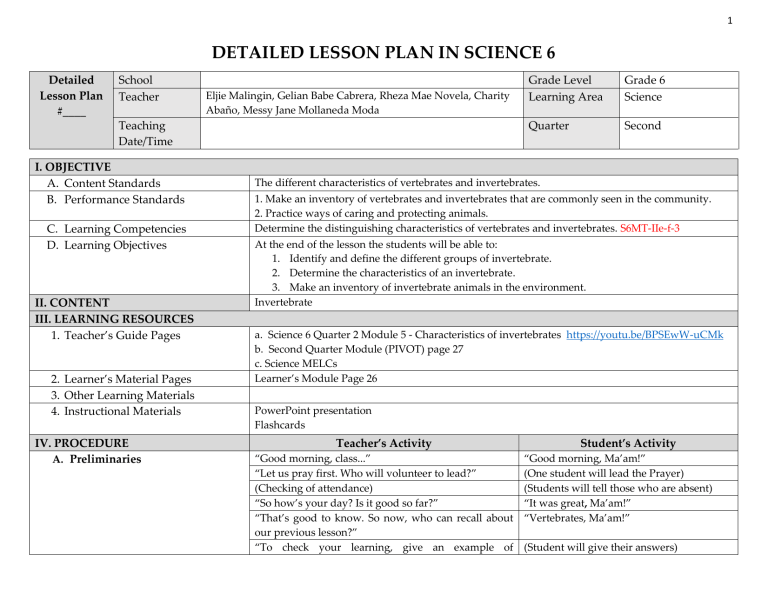
1 DETAILED LESSON PLAN IN SCIENCE 6 Detailed Lesson Plan #____ School Teacher Eljie Malingin, Gelian Babe Cabrera, Rheza Mae Novela, Charity Abaño, Messy Jane Mollaneda Moda Teaching Date/Time I. OBJECTIVE A. Content Standards B. Performance Standards C. Learning Competencies D. Learning Objectives II. CONTENT III. LEARNING RESOURCES 1. Teacher’s Guide Pages 2. Learner’s Material Pages 3. Other Learning Materials 4. Instructional Materials IV. PROCEDURE A. Preliminaries Grade Level Learning Area Grade 6 Science Quarter Second The different characteristics of vertebrates and invertebrates. 1. Make an inventory of vertebrates and invertebrates that are commonly seen in the community. 2. Practice ways of caring and protecting animals. Determine the distinguishing characteristics of vertebrates and invertebrates. S6MT-IIe-f-3 At the end of the lesson the students will be able to: 1. Identify and define the different groups of invertebrate. 2. Determine the characteristics of an invertebrate. 3. Make an inventory of invertebrate animals in the environment. Invertebrate a. Science 6 Quarter 2 Module 5 - Characteristics of invertebrates https://youtu.be/BPSEwW-uCMk b. Second Quarter Module (PIVOT) page 27 c. Science MELCs Learner’s Module Page 26 PowerPoint presentation Flashcards Teacher’s Activity “Good morning, class...” “Let us pray first. Who will volunteer to lead?” (Checking of attendance) “So how’s your day? Is it good so far?” “That’s good to know. So now, who can recall about our previous lesson?” “To check your learning, give an example of Student’s Activity “Good morning, Ma’am!” (One student will lead the Prayer) (Students will tell those who are absent) “It was great, Ma’am!” “Vertebrates, Ma’am!” (Student will give their answers) 2 B. Motivation C. Presentation D. Discussion vertebrate animals.” “Very good, today we will have a new lesson and let’s “Yes, Ma’am!” begin this with a word picture activity! Are you ready? Word Picture Activity The students will identify the animal base on the picture being shown by the teacher. They will come up with the following words: 1. Sponges 2. Jellyfish 3. Worms 4. Snail 5. Starfish 6. Spider “Very nice! I am very pleased you were able to (Students will give their answers) identify the animals in the pictures. Now, what do you observe with these animals?” “Very good! They don’t have bones and it is called invertebrates.” “So our lesson for today is about invertebrates.” “Now that you already know the meaning of (Students will give their answers) vertebrate. What is the meaning of invertebrates?” “Very good, Invertebrates can be simply identified as animals that do not have a backbone or mainly lack a Skeletal system. This means most of them do not possess a rigid body structure and as a result, cannot grow very large.” “To compensate for the lack of an internal skeleton, most invertebrates have an external skeleton called exoskeleton that protects their soft, inner body. This material is usually made from chitin, a derivative of glucose.” “One reason for the success of invertebrates is how quickly they reproduce. Sponges and corals, for example, produce both eggs and sperm. Social insects such as ants and bees lay eggs that can develop 3 without fertilization—they become the workers. The total number of invertebrate species could be 5, 10, or even 30 million, compared to just 60,000 vertebrates. ” “Invertebrates can be divided into smaller groups or phyla.” “Invertebrates are widespread in every environment and are divided into eight main groups; Porifera, Coelenterates, Platelminti, Nematodes, Annelids, Arthropods, Molluscs, Echinoderms” "Now that you already know the eight main groups of invertebrates. Let's now proceed to the four common traits of invertebrates." “Invertebrates share four common traits: 1. They do not have a backbone. 2. They are multicellular. 3. All the cells have different responsibilities in keeping the animal alive. 4. They have no cell walls, like all other animals. 5. They reproduce by two reproductive cells, or gametes, coming together to produce a new organism of their species.” "Now that you already know that invertebrates are (Students will give their answers) animals that do not have bone. Please give me some examples of animals without a bone." "Very Good! They don't have bones and they are Invertebrates." E. Analysis “Fill in the table using the list of animals in the box. Is it clear?” (Students answer:”Yes Ma’am”) 4 Centipedes Dolphin Tamaraw Monkey Mosquito Beetle Bat Mouse Rabbit Ant Snail Jellyfish Worms Insects Spider Vertebrates “Write it on your notebook.” F. Generalization G. Application H. Evaluation I. Assignment V. REMARKS VI. REFLECTION A. No. of learners who earned 80% in the evaluation Invertebrates (Student answers:”Okay Ma’am.”) “Now, class, let’s remember that invertebrate animals that do not have a backbone or mainly lack a Skeletal system. Also invertebrate are divided into eight main groups; Porifera, Coelenterates, Platelminti, Nematodes, Annelids, Arthropods, Molluscs, Echinoderms ” Individual Activity: The students will make a Venn diagram showing the differences and similarities of a vertebrates and invertebrates. Directions: Read each question carefully and answer the questions. 1. What type of animals has a backbone? 2. What type of animal does not have bone? 3. How many phyla of invertebrates are there? 4. Classify the different phyla of invertebrates. 5. Give 2 examples in each phylum. In a long bond paper the students will draw example of invertebrate animal and explain the different ways of caring and protecting the animal. 5 B. No of learners who require additional activities for remediation C. Did the remedial lesson work? No. of learners who have caught up with the lesson D. No. of learners who continue to require remediation E. Which of my teaching strategies worked well? Why did these work? F. What difficulties did I encounter which my principal or supervisor can help me solve? G. What innovation or localized materials did I use/discover which I wish to share with other teachers?
